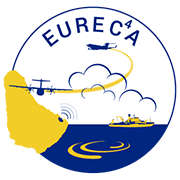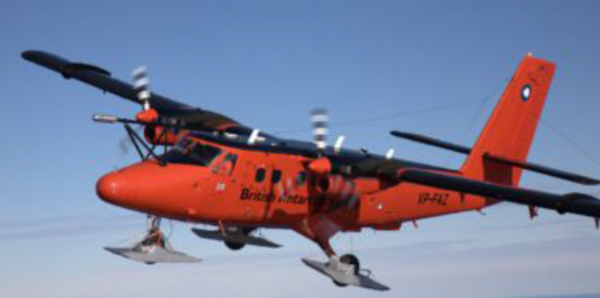BAS Twin-Otter
The UK Twin Otter ( schematic) is a high-wing, twin-engine, turbo-prop aircraft. It is known for its rugged construction, reliability and short take-off and landing performance. During EUREC4A a Twin-Otter from the British Antarctic Survey will be deployed from Barbados. It is due to arrive on the 13th of January, with the aim of being ready to fly on the 20th. The final date of science flights is planned for February 16th, with the plane departing February 21st. The aircraft will focus on aerosol and cloud microstructure (turbulence and microphysics) measurements. It is planned to fly two PMS-based measurement systems on each of the two wing hard points, implying different instrument configurations on different flights. Aerosol is sampled through a Brectel 1200 Isokinetic Inlet, which is greater than 95% efficient for 0.01 to 6μm. The Twin-Otter has a nominal range of 1400 km with a maximum speed of 140 knots and a ceiling of 5 km. During EUREC4A it is anticipated to fly at altitudes below 2 km to measure cloud and aerosol properties. A total of 100 flight hours have been budgeted, and twice daily flights are anticipated, but will depend on crew duty schedules.
schematic) is a high-wing, twin-engine, turbo-prop aircraft. It is known for its rugged construction, reliability and short take-off and landing performance. During EUREC4A a Twin-Otter from the British Antarctic Survey will be deployed from Barbados. It is due to arrive on the 13th of January, with the aim of being ready to fly on the 20th. The final date of science flights is planned for February 16th, with the plane departing February 21st. The aircraft will focus on aerosol and cloud microstructure (turbulence and microphysics) measurements. It is planned to fly two PMS-based measurement systems on each of the two wing hard points, implying different instrument configurations on different flights. Aerosol is sampled through a Brectel 1200 Isokinetic Inlet, which is greater than 95% efficient for 0.01 to 6μm. The Twin-Otter has a nominal range of 1400 km with a maximum speed of 140 knots and a ceiling of 5 km. During EUREC4A it is anticipated to fly at altitudes below 2 km to measure cloud and aerosol properties. A total of 100 flight hours have been budgeted, and twice daily flights are anticipated, but will depend on crew duty schedules.
Instrumentation:
| Total Temperature | Goodrich Rosemount Probes are mounted on the nose: A non de-iced model 102E4AL and a de-iced model 102AU1AG are logged at 0.7Hz. |
| State Parameters | Static and Dynamic pressure from the aircraft static ports and heated pitot tube are logged using Honeywell HPA sensors at 5Hz. A position accuracy of about 5m recorded at 10Hz from the JAVAD 4-antenna GPS attitude system. For greater accuracy this is supplemented by a Trimble 5700 survey system using an antenna mounted above the laser altimeter and processed in kinematic mode with a second ground based unit. An OXTS Inertial+ GPS linked inertial Measurement Unit (IMU) provides attitude and position information at 20Hz. |
| Hygrometer | A Buck 1011C cooled mirror hygrometer is fitted. Chamber pressure and mirror temperature are recorded at 1Hz. A Rosemount mounted Vaisala Humicap sensor is also logged. |
| Radiometers | Eppley PIR and PSP sensors fitted to the roof and underside of the aircraft. Logged at around 10 Hz. |
| Infra-red Thermometer | Heimann model KT19.82 infra-red thermometer mounted in the floor hatch panel. There is a solenoid-operated, ambient temperature, black-body calibration target that can be brought into view during flight. Data are recorded at around 10Hz. |
| Turbulence Probe | The NOAA/ARA BAT 'Best Aircraft Turbulence' probe is fitted on a boom extending forward from the roof of the aircraft. This 9 hole probe records pressures and exposed thermocouple temperatures for measuring turbulence by eddy covariance in conjunction with attitude measurements. 3-axis accelerometer data are also recorded from the BAT Probe. Heaters are fitted inside the hemisphere to enable the instrument to be usable even after encountering icing. |
| H2O and CO2 | The LICOR LI-7000 is a closed path infra-red gas analyser. Sampling is from a Rosemount inlet and readings are triggered at 50 Hz. |
| CN Counter | The TSI 3010 CPC can sample aerosol (condensation nuclei) particles between the range of about 10 nm to greater than 3 um. |
| Aerosol Spectrometer | A Grimm model 1.109 portable aerosol spectrometer has 31 channels ranging from 0.25μm to 32μm. |
| CCN Counter | A DMT single-column cloud condensation nuclei (CCN) counter model measures the spectrum of CCN concentration as a function of supersaturation continuously using uninterrupted flow and a multichannel, optical particle counter that measures the size of the activated droplet. |
| Scanning Mobility Particle Sizer | A TSI SMPS comprising of an electrostatic classifier (3082) and a condensation particle counter (3775) is capable of measuring aerosol particles from a few nanometres up to a micron. |
| Stereo Cloud Particle Imager | The 2D Stereo (2D-S) instrument is an optical imaging probe that provides cloud particle images, size and concentration. Shadows from particles illuminated by two orthogonal laser beams fall onto the two linear 128-photodiode arrays (10 micron resolution). The sample volume is approximately 10 L s-1*. The probe is mounted in an under-wing pod. The measurements include: Particle size (10 to 1280 µm), concentration and shape and derived liquid (or ice) water content. (Instrument Team: Gallagher/Dorsey/Bower, UoM) |
| In Situ Cloud Particle Imager | he High-Volume Precipitation Spectrometer (HVPS-3) detects shadows of particles on a single optical linear photodiode array with 128 channels of 150 µm pixel resolution, giving a sizing range up to 19,200 µm. The HVPS-3 uses the same photodiode array and electronics as the 2D-S. The sample volume is approximately 72 L s-1*. The probe is mounted in an under-wing pod. The measurements include: Particle size (150 µm to 19.2 mm), concentration and shape; derived liquid water content. (Instrument Team: Choularton (PI)/Crosier/Bower/Dorsey, UoM) |
| In Situ Cloud Probe | The Fast-Forward Scattering Spectrometer Probe (F-FSSP) is based on the original design of Knollenberg, and modified to produce high-rate measurements. Single particles are detected by measuring the intensity of light that the particle scatters in the forward direction when passing through a laser beam. The sample volume is 0.02 L s-1*. The probe is mounted in an under-wing pod. The measurements include: High speed (50-100 Hz) droplet size (1.5 to 50 µm diameter) and concentration; and derived liquid water content. (Instrument Team: Bower/Dorsey/Gallagher, UoM). |
| DMT Cloud/Aerosol Probes | The Cloud Aerosol and Precipitation Spectrometer (CAPS) is a combination of a hot-wire liquid water content instrument, a Cloud and Aerosol Spectrometer (CAS) and a Cloud Imaging Probe (CIP). Particle sizes from approx 0.5 μm to 1600 µm, can therefore be measured with a single instrument, minimizing space requirements. The instrument is mounted in an under-wing pod. (The hot-wire instrument Liquid Water Content instrument will not be used.) The individual components of CAPS to be used are described below. 1) Cloud Imaging Probe (CIP-25): Shadows of particles passing through a collimated laser beam are projected onto a linear 64-element photodiode array with 25 µm resolution. The sample volume is approximately 10 L s-1. The measurements include: particle size (25 to 1600 µm), concentration and shape, and derived liquid and/or ice water content. 2) Cloud Aerosol Spectrometer (CAS): an optical scattering instrument configured to measure aerosols and cloud particles in the same manner as the F-FSSP/CDP. The sample volume is 0.015L s-1. The measurements include: Aerosol and cloud-drop sizes (0.5 to 50 µm diameter) and concentration, particle refractive index and phase. |
| DMT Cloud Droplet probe | The DMT Cloud Droplet Probe (CDP-100) is an optical particle spectrometer that measures the concentration and size distribution of cloud droplets. The instrument is similar to the F-FSSP. Measurements are usually provided at 1 Hz in the standard data files but can be made available at 10 Hz in special high-rate processing. The sample volume is 0.015 L s-1*. The instrument is mounted off-fuselage below the nose cone of the Twin Otter aircraft. The measurements include: cloud droplet sizes (2 to 50 µm), concentration and integrated cloud liquid water content. (Instrument team: Bower/Dorsey/Gallagher UoM) |
| DMT Passive Cavity Aerosol Spectrometer | The DMT Passive Cavity Aerosol Spectrometer (PCASP-100X) collects light scattered over angles 35-120o by single particles that pass through the beam generated by a HeNe multi-mode classical passive cavity laser. The scattered light intensity covers more than six orders of magnitude to allow detection and sizing of small aerosol particles. The sample volume is 1 cm3 s-1. The probe is mounted in an under-wing pod. The measurements include: aerosol particle sizes (0.1 to 3.0 µm) and concentration. (Instrument team: Bower/Gallagher/Dorsey, UoM). |
PI/Contact:
Alan Blyth of the University of Leeds and the National Center for Atmospheric Science at Leeds.

